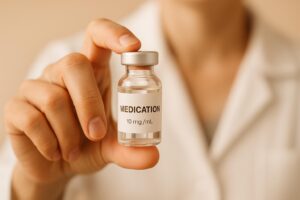Which GLP-1 Causes Least Nausea? An Insight into GLP-1 Medications and Their Side Effects

Introduction
Did you know that approximately 12% of Americans have taken a GLP-1 medication at some point? This statistic underscores the growing acceptance and reliance on these powerful medications for diabetes management and weight loss. As more people turn to GLP-1 receptor agonists, understanding their side effects becomes crucial. Nausea is the most frequently reported side effect, affecting roughly 30-40% of users. However, the experience of nausea is not uniform across all GLP-1 medications.
In this blog post, we will delve into the various GLP-1 medications available, the reasons behind nausea as a side effect, and which specific GLP-1s are associated with lower rates of nausea. We will also provide insights into how TrimRx’s personalized weight loss solutions can help you navigate these medications effectively. Our goal is to foster a supportive environment that encourages informed decisions about weight loss and overall health.
What You Will Learn
- An overview of GLP-1 medications and how they work.
- The common side effects associated with GLP-1 receptor agonists, focusing on nausea.
- A comparison of different GLP-1 medications and their nausea profiles.
- Practical tips to manage nausea while using GLP-1 medications.
- How TrimRx can support your weight loss journey with personalized, medically supervised solutions.
Let’s embark on this journey toward understanding GLP-1 medications and how we can make your weight loss experience as comfortable and effective as possible.
The landscape of weight management and diabetes treatment has evolved significantly in recent years, with glucagon-like peptide-1 (GLP-1) receptor agonists taking center stage. These medications are increasingly recognized not just for their effectiveness in managing type 2 diabetes but also for their remarkable ability to facilitate weight loss. However, one common hurdle faced by many users is the side effect of nausea. In this blog post, we will explore which GLP-1 medications are associated with the least nausea, the underlying reasons for this side effect, and strategies to mitigate it.
At TrimRx, our mission is to empower individuals on their weight loss journey with personalized, medically supervised solutions. As we navigate through the complexities of GLP-1 medications, we aim to provide clarity and support for those considering or currently using these treatments. By the end of this post, you will have a deeper understanding of GLP-1 medications, their side effects, and practical advice to enhance your experience.
Understanding GLP-1 Medications
GLP-1 receptor agonists are a class of medications that mimic the action of the GLP-1 hormone, which is naturally produced in the intestines. This hormone plays a crucial role in regulating blood sugar levels and appetite. When you eat, GLP-1 is released, leading to several physiological responses:
- Stimulating insulin secretion: GLP-1 promotes insulin release from the pancreas, helping to lower blood sugar levels.
- Inhibiting glucagon release: It reduces the secretion of glucagon, a hormone that raises blood sugar levels, thereby enhancing overall glucose control.
- Delaying gastric emptying: By slowing the rate at which food leaves the stomach, GLP-1 helps to increase satiety and reduce appetite.
These actions collectively contribute to the effectiveness of GLP-1 medications in managing type 2 diabetes and promoting weight loss. Currently, several GLP-1 receptor agonists are FDA-approved, including:
- Semaglutide (Ozempic, Wegovy)
- Liraglutide (Victoza, Saxenda)
- Dulaglutide (Trulicity)
- Exenatide (Byetta, Bydureon)
- Tirzepatide (Mounjaro, Zepbound)
The Rise of GLP-1 Medications for Weight Loss
The popularity of GLP-1 medications for weight loss has surged, with many users reporting significant weight loss results. A recent meta-analysis found that semaglutide is particularly effective for weight management, leading to substantial reductions in body weight when combined with lifestyle changes. However, while these medications are effective, they are not without side effects.
Common Side Effects of GLP-1 Medications
Among the most common side effects of GLP-1 medications are gastrointestinal disturbances, with nausea being the most prevalent. Other side effects may include vomiting, diarrhea, and constipation. Understanding these side effects is critical for anyone considering or currently using GLP-1 medications.
Nausea: Why Does It Occur?
Nausea is primarily attributed to the way GLP-1 medications affect gastric emptying. By slowing down the digestive process, these medications can lead to feelings of fullness or discomfort, which may manifest as nausea. Additionally, individual responses to these medications can vary widely, with some users experiencing mild nausea and others facing more severe symptoms.
The Prevalence of Nausea in GLP-1 Users
Research indicates that nausea can affect 30-40% of patients using GLP-1 medications. While this side effect is often mild and transient, it can be a significant barrier for some individuals, leading to discontinuation of treatment.
Which GLP-1 Medications Cause the Least Nausea?
As we explore the different GLP-1 medications, it is essential to highlight their varying nausea profiles. Studies have shown that the incidence of nausea is not uniform across all GLP-1s:
- Exenatide (Byetta, Bydureon): This medication is known to have lower rates of gastrointestinal side effects compared to others. Its short-acting formulation may lead to a reduced incidence of nausea.
- Lixisenatide (Adlyxin): Similar to exenatide, lixisenatide is associated with lower rates of nausea, making it a potential option for those sensitive to gastrointestinal side effects.
- Dulaglutide (Trulicity): This long-acting GLP-1 receptor agonist has been reported to cause nausea, but it tends to be less frequent compared to semaglutide.
- Semaglutide (Ozempic, Wegovy): While semaglutide is highly effective for weight loss, it also has a higher incidence of nausea, especially during the initial dose-escalation phase.
- Tirzepatide (Mounjaro, Zepbound): This newer medication appears to have a favorable nausea profile, but more research is needed to fully understand its gastrointestinal effects.
Comparing Nausea Profiles
To summarize, the following GLP-1 medications are associated with lower rates of nausea:
- Exenatide (Byetta, Bydureon)
- Lixisenatide (Adlyxin)
- Dulaglutide (Trulicity)
Conversely, semaglutide, while effective, is linked with higher rates of nausea. Understanding these differences can help individuals make informed choices about their GLP-1 medication options.
Managing Nausea While Using GLP-1 Medications
If you’re currently using or considering a GLP-1 medication, managing nausea is crucial for enhancing your treatment experience. Here are some practical tips to help mitigate nausea:
- Start with a Low Dose: Gradually increasing the dose allows your body to adjust more comfortably to the medication.
- Take Medication with Food: Consuming your medication with a meal can help slow absorption and reduce the likelihood of nausea.
- Stay Hydrated: Drinking plenty of fluids can help prevent dehydration, which may exacerbate feelings of nausea.
- Choose Bland Foods: Eating bland, non-spicy foods can help settle your stomach and minimize nausea.
- Avoid Strong Odors: Strong smells can trigger or worsen nausea. Try to avoid them whenever possible.
- Consider Anti-Nausea Medications: Speak with your healthcare provider about the potential use of anti-nausea medications if nausea persists.
- Maintain Regular Meal Patterns: Eating smaller, more frequent meals can help manage hunger and reduce nausea.
By implementing these strategies, many individuals find they can continue their GLP-1 treatment with reduced discomfort.
TrimRx: Your Partner in Personalized Weight Loss Solutions
At TrimRx, we understand that every weight loss journey is unique. Our personalized weight loss programs are designed to support you through every step of your transformation. With our free assessment quiz, we can help determine your eligibility for GLP-1 medications and create a tailored treatment plan that aligns with your specific needs and goals.
We are committed to providing compassionate care that respects your individual journey. Our comprehensive services include unlimited support, doctor consultations, and personalized medication plans, ensuring that you have the resources you need to succeed.
Take the First Step
If you’re considering a GLP-1 medication or want to learn more about how we can support your weight loss journey, we encourage you to take our free assessment quiz today: Take the Quiz.
Additionally, consider our quick-access supplements, such as GLP-1 Daily Support and Weight Loss Boost, which can enhance your overall wellness as you embark on your weight loss journey.
Conclusion
Navigating the world of GLP-1 medications can be complex, especially when considering the side effects associated with their use. Nausea is a common concern, but understanding which GLP-1 medications are linked with lower rates of nausea can empower you to make informed choices. Exenatide and lixisenatide emerge as favorable options for those sensitive to gastrointestinal side effects, while semaglutide, despite its effectiveness, may require additional management strategies to mitigate nausea.
At TrimRx, we are dedicated to providing personalized, medically supervised weight loss solutions that prioritize your health and comfort. By taking advantage of our resources and support, you can embark on a successful weight loss journey with confidence.
FAQ
What are GLP-1 receptor agonists?
GLP-1 receptor agonists are a class of medications that mimic the effects of the GLP-1 hormone, regulating blood sugar levels and promoting weight loss.
Which GLP-1 medication is most effective for weight loss?
Semaglutide has been identified as one of the most effective GLP-1 medications for weight loss, but individual responses may vary.
What should I do if I experience nausea while taking a GLP-1 medication?
Consider taking the medication with food, starting with a lower dose, and staying hydrated. If nausea persists, consult your healthcare provider for additional support.
Can I take GLP-1 medications if I don’t have diabetes?
Yes, certain GLP-1 medications are FDA-approved for weight loss in individuals without diabetes.
How can TrimRx support my weight loss journey?
TrimRx offers personalized weight loss programs, including doctor consultations, medications, and unlimited support tailored to your individual needs.
By understanding the nuances of GLP-1 medications and their side effects, we can work together to achieve your health and wellness goals.

Transforming Lives, One Step at a Time
Keep reading
Ultimate Guide to Semaglutide Dose Customization
This guide explores semaglutide dosing for diabetes and weight loss, emphasizing personalized adjustments for optimal results.
6 Common Drug Interactions with GLP-1 Medications
Learn about six common drug interactions with GLP-1 medications and how to manage potential risks for safe treatment.
Mounjaro Insurance Coverage: What to Know
Learn how insurance coverage for Mounjaro varies based on diabetes treatment and weight loss, along with tips for approval and cost-saving options.
Semaglutide vs. Tirzepatide: Max Dose
Explore the differences between two weight loss medications, their maximum doses, effectiveness, and safety profiles for better health outcomes.
GLP-1 Diet Plan: 7-Day Meal Guide
Learn how to effectively pair GLP-1 medications with nutritious meal planning for weight loss, improved digestion, and stable blood sugar.
Nausea and GLP-1 Medications: Solutions That Work
Learn effective strategies to manage nausea from GLP-1 medications, including dietary tips and the importance of personalized dosing.
5 Signs GLP-1 Medication Is Working for You
Learn the key signs that indicate your GLP-1 medication is effectively aiding weight loss, appetite control, and blood sugar management.
Plateau Problems: Restarting Weight Loss
Stalled weight loss on GLP-1 medications is common but manageable. Explore strategies to break through plateaus and regain momentum.
Body Fat Percentage Estimator – Know Your Stats
Estimate your body fat percentage in seconds with our free tool. Just input your height, weight, and more for instant results. Try it now!









